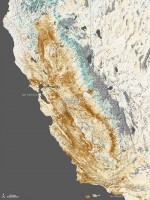Friday, March 14th, 2014
Researchers aboard NASA’s P-3 research aircraft left the agency’s Wallops Flight Facility in Wallops Island, Va., March 10 for Greenland to begin a new season of collecting data on Arctic land and sea ice.
Friday, March 7th, 2014
Researchers at NASA’s Marshall Space Flight Center in Huntsville, Ala., developed a sophisticated piece of flight hardware called a Lightning Imaging Sensor (LIS) to detect and locate lightning over the tropical region of the globe. Launched into space in 1997 as part of NASA’s Tropical Rainfall Measuring Mission (TRMM), the sensor undertook a three-year baseline
Thursday, February 27th, 2014
The Global Precipitation Measurement (GPM) Core Observatory, a joint Earth-observing mission between NASA and the Japan Aerospace Exploration Agency (JAXA), thundered into space at 1:37 p.m. EST Thursday, Feb. 27 (3:37 a.m. JST Friday, Feb. 28) from Japan.
Wednesday, February 26th, 2014
NASA is partnering with the California Department of Water Resources (DWR) to develop and apply new technology and products to better manage and monitor the state’s water resources and respond to its ongoing drought. NASA scientists, DWR water managers, university researchers and other state resource management agencies will collaborate to apply advanced remote sensing
Tuesday, February 25th, 2014
NASA officials will participate in a media briefing at 9:30 a.m. PST Tuesday, Feb. 25 about the agency’s work to use its Earth observation assets to help the state of California better manage its water resources and monitor and respond to its ongoing drought.

Sunday, February 23rd, 2014
Persistent dry weather has grown more worrisome in the American West, with nearly two thirds of the region experiencing some level of drought. By most measures, the state of California is suffering through the worst of it. The effects of the dry spell are visible in the mountains, where snow pack is lacking, and now
Friday, February 7th, 2014
The rover’s view of its original home planet even includes our moon, just below Earth. The images, taken about 80 minutes after sunset during the rover’s 529th Martian day (Jan. 31, 2014) are available at http://photojournal.jpl.nasa.gov/catalog/PIA17936 for a broad scene of the evening sky, and at http://photojournal.jpl.nasa.gov/catalog/PIA17935 for a zoomed-in view of Earth and the
Thursday, February 6th, 2014
It takes a lot of land to grow food for the world’s seven billion people. About a third of Earth’s terrestrial surface is used for agriculture. And about a third of that, in turn, is used to grow crops. Now, a new NASA-funded effort aims to map crop fields worldwide, identify what’s growing where, and
Thursday, February 6th, 2014
While felines in space may be what you’re thinking, the Cloud-Aerosol Transport System (CATS) is a much more helpful accompaniment planned for the International Space Station. CATS will study the distribution of aerosols, the tiny particles that make up haze, dust, air pollutants, and smoke.
Wednesday, January 29th, 2014
For the first time in more than a decade, five NASA Earth science missions will be launched into space in the same year, opening new and improved remote eyes to monitor our changing planet.